|
| Pete's Req (Riq) basics page |
Introduction to the sound
of Req
AUDIO
 VIDEO
VIDEO

This traditional drum has a fishskin
head which is glued onto the shell . The shell is approx 8 and a half
inches in diameter by 2 or 3 inches deep and made of wood. Five double
sets of heavy brass jingles are suspended in cut-outs in the shell.
Before the skin is glued in place, the shell is elaborately decorated
with a mosaic of ivory, mother-of-pearl or
other materials such as plastic etc. The detailed decoration work found
on these drums can be quite staggering. There are also tuneable
varieties of the drum and some fixed tension plastic skin versions by
REMO drum company. These drums can be
particularly effective and save you the problem of humidity effecting
the tuning. The drum should be tuned to a fairly high
cracking tone. With the traditional drum,
this high pitch can be achieved by holding it over a heat source. Some
players use a light bulb fixed inside a biscuit tin with holes in the
lid, some use tiny electric blankets, others cry because their drums
sound like cardboard boxes. I recommend you
proceed with caution if you try the biscuit tin idea. Use a low
wattage bulb (the lowest you can find) and be aware that even then it
still gets quite hot.
Let’s look at the basic playing positions and strokes. The
drum is held in the left hand. The thumb
locks onto the rear jingle and forms a clamp
with the first finger on the front bottom edge of the drum.
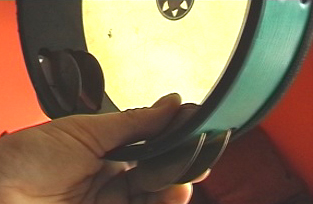
Thumb holding position inside drum.
Holding position for Req;
VIDEO

This frees up the ring finger to strike the bottom
jingle. The drum should fall slightly over
towards your left, causing your forearm to face upwards. Try not to
tense your arm and stiffen up when you hold
the drum in this position. The secret of all well-articulated technique
is relaxation. From this position, try
striking the bottom jingle with your ring finger (some players use the
middle finger for this stroke). Next we’ll introduce the
jingle strike with the other hand, again on
the same jingle with the tip of the ring finger. Start with an even 16th
level RLRL.
The dum and tek
and slap strokes are articulated with the right hand. The
dum stroke is played with the first finger
striking flat. Notice the finger moves in towards the centre of the head
slightly to help pull some of the bass sound out of the drum. The dum
stroke should be bass orientated, while the tek
(AKA tak) stroke is sharp and treble
orientated. It is important to hold the drum stable when articulating
these strokes. The last thing you want is a jingle wash underneath the
rhythms. The dum stroke is articulated with
the first finger, slightly in towards the centre of the drum whilst the
tek stroke is articulated right on the edge of the drum, almost like a
rim shot. It is played with the tip of the ring finger which strikes the
edge in a sharp and staccato manner bringing a high and clear note from
the drum. The final stroke we have is the
slap stroke, played with all four finger
tips in the centre of the head in a similar manner to the
Conga or Bongo
slap. Be patient with this stroke as it is worth the wait.
Here is a summary of the basic strokes on Req;
DUM; Right
hand open tone.
TEK; Right hand hi pitched tone on edge of
shell.
SLAP; Right hand in centre of drum.
JINGLE; Either right or left hand on the
jingle.
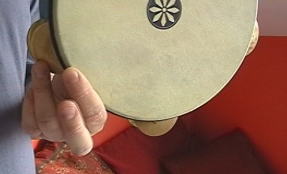
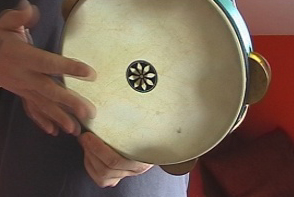
Striking the jingle with the left hand.
'DUM' open tone with the first finger
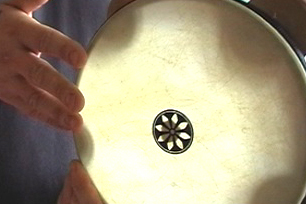
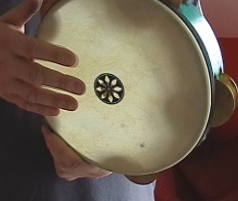
'TAK' right hand on the edge of the
skin.
'SLAP' in the centre of the head.
Here is how we will
notate them;

Here is the audio and video of these
basic strokes.
Basic strokes and jingle technique for Req
AUDIO
 VIDEO VIDEO

Slap stroke for Req
AUDIO
 VIDEO VIDEO


Spend some time working on the comfortable
execution of the sixteenths
jingle pattern demonstrated at the end of
the basic strokes files.
We can now begin to introduce some 'dum'
and 'tek'
sounds into the sixteenths jingle pattern.

Example 1 Click to
enlarge AUDIO AUDIO
 VIDEO
VIDEO

We can now begin to introduce some 'ruffs' into the
patterns as well. This is articulated by a quick 32nd note flurry
fingered 'RRRL'

Example 2 Click to
enlarge AUDIO AUDIO
 VIDEO
VIDEO

We introduce the 'slap' stroke for this traditional
sounding Arabic rhythm called 'Saadi'.

Example 3 (Saadi) Click to
enlarge AUDIO AUDIO
 VIDEO
VIDEO

The rhythms of Req can sound very effective even when
there are not a lot of 'dum' and
'tek' sounds being used. Check
out this quite sparse pattern.
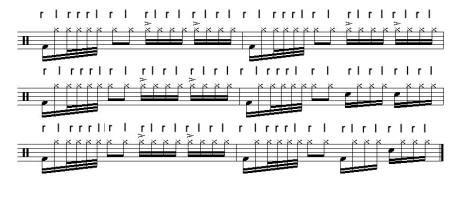
Example 4 Click to
enlarge AUDIO AUDIO
 VIDEO
VIDEO

There also a number of other techniques for
Req. Shaking the drum with the left
hand backwards and forwards as sixteenths
like a shaker whilst striking 'dum' and
'tek' can be very popular, either
continuously or in short bursts within the rhythm.
Jinngle ruffs and shaking techniques for
Req
AUDIO
 VIDEO VIDEO

Also, the 'SOFT' position
is a really skilled employment of the drum. The drum is held in a
vice like grip with both hands with the
fingers coming round the front of the drum. All the fingers are
then used to strike and/or mute the drum whilst playing. This
really in the art of Req. I will add
some more lessons on this a little later.
Demonstration of 'SOFT' position
for Req
AUDIO
 VIDEO VIDEO

ARABIC RIQ SOLO by PETE
If you feel you are benefiting from
these free and detailed lesson pages then please support the up keep of
the site by buying a CD :) In the meantime new lessons will be
added regularly.



|
